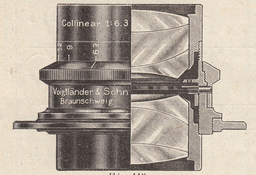Hunter_Compton
Member
I recently acquired a National Graflex Series II camera, it came with the Bausch and Lomb 140mm Telephoto accessory lens.
I don't see this lens talked about much, not sure if they're just scarce. However, I had to take the one I received with my National apart to free the sticky aperture, I was surprised to see it's a six elements in two groups design. Each a cemented triplet. This is especially surprising given the low speed (f/6.3) of the lens.
I looked through some of my lens books, but found nothing referencing a design similar to this. Anyone familiar with this design or where it originates? It seems highly expensive.

I don't see this lens talked about much, not sure if they're just scarce. However, I had to take the one I received with my National apart to free the sticky aperture, I was surprised to see it's a six elements in two groups design. Each a cemented triplet. This is especially surprising given the low speed (f/6.3) of the lens.
I looked through some of my lens books, but found nothing referencing a design similar to this. Anyone familiar with this design or where it originates? It seems highly expensive.











